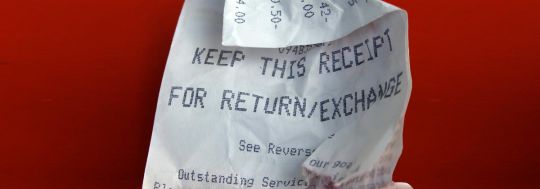What are your rights when it comes to a refund?

Sometimes we buy something that doesn’t work or falls apart. So what are your rights to a refund in Australia?
When you buy products or services they come with automatic guarantees under the Australian Consumer Law that they will do all the things you would normally expect them to do. They must also be safe, lasting, with no faults and look acceptable. Acceptable quality takes into account what would normally be expected for the type of product and cost.
If there is a problem with goods you have bought, the store may have to provide a replacement, refund, repair or other type of ‘remedy’ depending on the problem. You are entitled to return a faulty item to the store under certain conditions.
Let’s use a toaster to illustrate when an item is considered faulty:
- It does not do what it’s normally supposed to do – for example, my toaster doesn’t toast bread.
- It has a defect – my toaster’s timer knob fell off soon after I bought it.
- It is unacceptable in appearance or finish – my toaster is scratched.
- It is unsafe – sparks fly out of my toaster.
- It isn’t durable – my toaster broke down only three months after I bought it.
You are not entitled to return an item when:
- The store told you (or displayed a sign) about hidden defects before you bought it.
- You examined the item before buying and didn’t find defects you should have noticed.
- You used the item in an ‘abnormal’ way, or
- You have used the item for a very long time.
Buying online: What is drip pricing?
Other reasons to request a refund
You can return a faulty item even if you have worn or used it, removed the tags or labels, or removed it from its original packaging. For instance, you may have bought a shirt, worn it a few times but the dye ran the first time you washed it, even though you followed the instructions on the label.
If you buy an item based on a sample or model, it must match that sample. A chair in a different colour or fabric to the sample ordered entitles you to a refund.
A handbag described as ‘leather’ in the store’s catalogue turns out to be vinyl and so different from the description that you would not have bought it, had you known this beforehand.
If the salesperson told you an item would do what you wanted and it doesn’t, return it for a refund.
I changed my mind…
We’ve already noted that consumer guarantees are not valid if you knew of or should have been aware of the faults before you bought the product. However, stores don’t have to accept a returned item if you got what you asked for but simply changed your mind, found it cheaper elsewhere, decided you did not like the purchase or had no use for it. On the other hand some stores do have their own in-store policy to offer a refund, exchange or credit note for ‘change-of-mind’ purchases so it pays to be aware of individual store policy.
Other reasons a refund can be refused is when the product has been misused in a way that caused the problem, or you have asked for a service to be done in a certain way that is contrary to advice, or you were unclear about what you wanted.
I bought it online…
If you bought from an Australian business online, you have the same refund rights as when buying from a shop – unless you bought the item from a private seller in which case the seller has no obligation to refund, replace or repair the item you bought from them (for example, at a garage sale or through a classified ad).
‘No refund’ signs and expired warranties
It is against the law for businesses to tell you or show signs stating that they do not give refunds under any circumstances, including for gifts and during sales. Your rights under the consumer guarantees do not have a specific expiry date and can apply even after any warranties you’ve got from a business have expired.
You can claim a remedy from the retailer if the products do not meet any one or more of the consumer guarantees, with the exception of availability of spare parts and repair facilities. The remedies you can seek from the retailer who sold you the product include a repair, replacement or refund and in some cases compensation for damages and loss.
The retailer can’t refuse to help you by sending you to the manufacturer or importer.
Receipts can be your best friends
It’s always a good idea to get a receipt or other proof of purchase for products and services you buy. Keep all records just in case something goes wrong later. You will need to prove the item was purchased from that particular business. If you don’t have the cash register receipt, other types of proof of purchase include:
- credit or debit card statement, clearly itemised to support your claim
- a lay-by agreement
- a receipt or reference number given for phone or internet payments
- a warranty card showing the supplier’s or manufacturer’s details and the date or amount of the purchase
- a serial or production number linked with the purchase on the supplier’s or manufacturer’s database
- a copy or photograph of the receipt
Keep receipts in a safe, dry place and take a copy of them if you are worried about fading. You can use the ACCC Shopper app to store your receipts as photos on your phone.
Know your rights
It’s inevitable that something will go wrong somewhere along the retail thread in your life but being clear on your rights will go a long way towards a satisfactory outcome. Find out more on the Australian Competition and Consumer Commission website – www.accc.gov.au/consumers
Try our Transaction Accounts comparison tool to instantly compare Canstar expert rated options.







